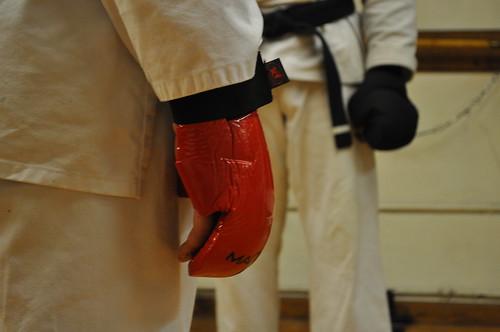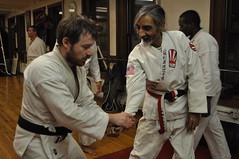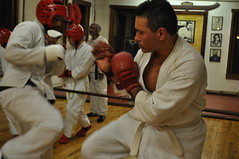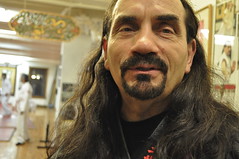 Meredith Hoffman Students at the Nisei Goju International Headquarters prepare to spar. Below: Students practicing Nisei Goju, a combination of hard and soft fighting styles.
Meredith Hoffman Students at the Nisei Goju International Headquarters prepare to spar. Below: Students practicing Nisei Goju, a combination of hard and soft fighting styles.Black hair cascading down the back of his karate robe, Master Wilfredo Roldan exhaled an impassioned hiss in the Nisei Goju International Headquarters on Seventh Street and Avenue A.
For 41 years, Mr. Roldan has taught Nisei Goju – a martial art that borrows from karate and jiujitsu and emphasizes the importance of discipline, a lesson that his students already seem to have taken on board: at Mr. Roldan’s gesture, the entire class bows, kicks and springs into action.
There are just seven students in the class – and Mr. Roldan said that the small setting is by design.
“I say, ‘Joseph only had 12 brothers, Jesus had 12 disciples’ — there are very few people you can touch,” said Mr. Roldan, who is 59 and who does not use the religious analogy by accident – he says his work is a service, and compares Nisei Goju to a spiritual calling.
It is also a fighting technique that teaches students to use the leverage of an opponent to gain an advantage. At a recent session, students practiced disarming opponents with knives and fending off punches.
“It’s an enclosed fighting system, so we use a lot of hand movement,” said Mr. Roldan, who is called “Hanshi” – or teacher – by his students.
For Evan Baker, a tall, intense fighter whose punches tore through the air, Mr. Roldan has helped him since 1979, when Mr. Baker’s grandmother sent him to the studio to learn self-defense.
“We were going to the inner-city schools around here so she wanted to make sure we knew how to fight, in case we had to,” said Mr. Baker. “We were kids sparring with each other, there weren’t any mats — it was a very different scene, but it resonated with me, the discipline.”
Mr. Baker left the studio and didn’t return until years later, when he ran into Mr. Roldan on the street. Facing hard times, Mr. Baker was studying for his masters in social work — while he was homeless, staying in an East Village shelter.
“Hanshi let me come take classes here for free, in exchange for cleaning. I was struggling with joblessness, trying to get through graduate school, and not being overwhelmed,” said Mr. Baker. “He really helped me out. It’s been such a transition for me, since I’ve started with him.”
Mr. Baker successfully completed his masters in social work, and now works at Rikers Island prison. He lives in Park Slope with his wife and child, and continues to come to the studio regularly.
“We’re like a family here. There ain’t no black, no Puerto Rican,” said Mr. Baker. “None of that racism nonsense. It’s like one of our mottos: Our art and our cause is for the purpose of aiding all mankind.”
The studio is also age-blind, with teenagers fighting beside middle-aged men. Che Raskin, 14, with wavy hair and a shy grin, said he unsuccessfully searched for the perfect karate studio, and finally found Mr. Roldan.
“I tried it, and it felt real,” said Che, who has been practicing Nisei Goju for two years.
According to Mr. Roldan, Goju is a blend of hard and soft fighting styles; “Go” means “hard” and “ju” means “soft.” Mr. Roldan calls his style Nisei Goju, meaning “second-generation” Goju, since he studied with Peter Urban, who brought Goju to the U.S. in 1967.
“It’s a way of life. When I eat, sleep, everything I do is martial based,” said Mr. Roldan.






